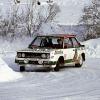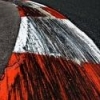When were the roads of the Isle of Man (or Northern Ireland circuits) surfaced with tarmac?
Back to this question... From a book about the early Tourist Trophy car races ('Tourist Trophy' by Richard Hough, 1957), there are a few mentions of the track surfaces. From a quick skim through, here's the relevant bits, mostly about the Isle of Man courses, plus a couple about the Ards course (but not so many - presumably the surfaces everywhere were generally better by then):-
Isle of Man circuits (1905-22):-
(1905)
The course was an admirable one that included every condition likely to be met by the most adventurous Edwardian tourist. Fifty-two miles per lap, almost as many corners as the Targa Florio, a loose surface that could turn to a shallow quagmire in rain, required to be sprayed with a substance called Westrumite, in order to abate the dust nuisance, if it was dry. The surface gave the impression of 'a series of small undulations which make a car dance and jump in an astonishing manner when real speed is attempted'.
(The quoted part is quoted in the book, but with no obvious indication who it should be attributed to.)
(1914 & 22)
For the last two T.T.s on this course the surface was slightly improved. There was macadam and even tarmac on some portions although dust was still a menace when the road was dry, and the dust-laying calcium chloride - excruciatingly painful to the eyes - an almost equal menace when the road was wet.
(Quote from 'The Motor' by Kenelm Lee Guinness, winner in 1914)
There is no doubt that this is a very difficult course, particularly if it is a wet day, as the road conditions vary so greatly and also so frequently. In some places one comes quite suddenly off a soft macadam road on to a surface faced with something not asphalt but apparently quite as hard.
1908 (4-inch) race:-
The road surface was given special attention, the entire course being swept by hand and then treated with a a new dust-laying substance, Akonia dressing, which was laid by two traction engines towing trailers. That notorious section between Sulby Bridge and the village was tarred, a treatment that was found disconcertingly slippery by many drivers, especially in the wet.
1914:-
The roads were still almost entirely untarred and were quite inadequate for cars with top speeds in the 90's.
1914 again:-
It was still pelting and blowing half a gale on Wednesday morning, and though it had stopped by breakfast, the dust-laying calcium chloride which some misguided official had ordered to be put down prevented the surface from drying out, and incidentally gave some agony to the drivers who got it in their eyes and had little sleep that night.
Ards (1928-36):-
Comber's camber was notorious, but for the small cars it had its uses, notably as banking, though the loose surface both here and at Newtonards in the early days could be diabolical, especially to naked arms protruding from cockpits.
1932:-
The course was faster than ever, with a new smooth non-skid surface.
[Edited to correct a couple of typos]



























